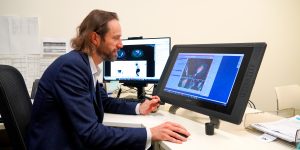Radiation oncologists at the Royal Adelaide Hospital (RAH) are leading the way with advanced radiotherapy treatments for pancreatic cancer.
The AGITG MASTERPLAN study, coordinated by the NHMRC clinical trials centre at the University of Sydney, is testing the addition of cutting-edge radiotherapy techniques to standard treatment and benefits from nation-leading local expertise.
Next-generation treatment
Stereotactic body radiotherapy is the most advanced form of radiotherapy, providing focussed, high dose radiation to the tumour and less radiation to the surrounding normal tissue compared to conventional radiotherapy.
As an investigational treatment in pancreas cancer, it is not yet part of the standard treatments in Australia.
Trials such as MASTERPLAN are key to understanding how it can be best utilised to manage Australia’s fifth highest cause of cancer related mortality.
“At the RAH, we’ve led the way with stereotactic body radiotherapy in the pancreas setting,” said Principal Investigator, Associate Professor Hien Le.
“We’ve treated more patients here using this technique than any other institution in Australia.”
Surgery remains the only curative treatment option for patients with pancreatic cancer but is only feasible in 10-15 per cent of patients.
“Most cancers are in the head or the neck of the pancreas, which is a difficult location to operate as there are a lot of blood vessels in the area,” said A/Prof Le.
Pancreatic cancer is conventionally treated with chemotherapy, a systemic treatment.
Clinical trials in other cancers such as oesophageal and rectal cancer indicate the potential strength of adding radiation prior to surgery, which may reduce the size of tumours and increase the feasibility of surgery.
“There’s this hunch that local treatment (with radiotherapy) is useful, but we need to test that,” said A/Prof Le.
Using the latest generation of radiation therapy offers several advantages over conventional external beam radiotherapy.
The focussed, high dose radiotherapy reduces the number of required treatment sessions and the burden of travel for patients, particularly those coming from rural locations.
“It’s logistically advantageous for the patient. Instead of coming 28-30 times for conventional radiotherapy, instead they’ll come five times,” said A/Prof
Leading the way
Researchers at the RAH have been instrumental in developing the protocol for the multicentre AGITG MASTERPLAN study, which could provide a meaningful contribution to Australia’s radiotherapy capabilities.
To be an institution eligible to recruit patients for a study such as this, certain criteria need to be met, relating to hardware, software, processes, and technology in addition to experience.
“Fortunately, at the RAH, we have been doing this for a long time, so we have been able to hit the ground running,” said A/Prof Le.
“For other departments, this is a way forward; it’s a vehicle to bring this technology into their framework.”
“I’m really proud of our team, to be able to bring this treatment option to the community here in South Australia. This treatment is offered more widely overseas, so I’m proud that we can take the lead locally.”
More about the study
Read more about the MASTERPLAN study on the Australasian Gastro-Intestinal Trials Group and the GI Cancer Institute website.



